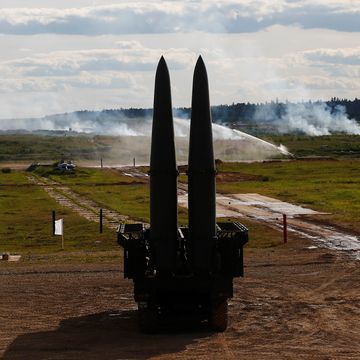A new analysis of satellite photos taken of a Russian ammunition depot suggests that more than 2,000 20-foot cargo containers were shipped from North Korea to Russia. According to a Ukrainian Army reserve officer—well known for his commentary under the handle ‘Tatarigami UA’—those containers likely carried half a million 122- and 152-millimeter artillery shells. And that estimate “leans toward the conservative side.” These findings and supporting imagery are laid out in an article on his website Frontelligence Insight.
Russia burned through a staggering 11 million artillery rounds in 2022 attempting to secure a quick victory in Ukraine—without success. But with industrial capacity to build only 2 million more shells per year, Russia couldn’t expend its ammunition as wastefully in 2023. Instead, its projected Russia will “only” expend 7 million shells this year—just two-thirds of their 2022 total.
Not coincidentally, for much of 2023, rumors have been looming of a huge transfer of artillery ammunition from North Korea to Russia. These were substantiated by Russia’s open outreach to North Korea—including a visits by Russian defense minister Sergei Shoigu in July and chief diplomat Sergey Lavrov in October and a meeting between Putin and Kim Jong Un in September.
The transfers were ultimately confirmed by U.S. intelligence reports this Fall. The first photos finally emerged onto social media in mid-October, showing 122- and 152-millimeter shells built in North Korea in the 2000s.
These two calibers are by far the most common types used in Russia and Soviet artillery systems. 122-millimeter shells see a lot of use in hundreds of D-30 towed howitzers and 2S1 Gvozdika (‘Carnation’) armored self-propelled systems.
152-millimeter caliber weapons are even more ubiquitous. These include the older medium-range 2S3 Akatsiya and long-range 2S5 Gigantsit, as well as the modern 2S19 and 2S33 Msta. There are also towed equivalents to those self-propelled weapons, including old D-20 howitzers, long-range 2A36 Giatsint-B field guns, and 2A65 Msta-B howitzers.
The new analysis, however, helps answer an overhanging question: just how much ammunition did North Korea actually give Russia?
Counting Russia’s North Korean ammunition haul
A previous U.S. intelligence report illustrated (with satellite photos) that the Russian container ship M/V Angara ferried hundreds of containers from Najin, North Korea to Dunay, Russia across Ussuri Bay from Vladivostok. From there, the containers were transported well over 4,000 miles by train to an ammunition depot 180 miles southeast of Ukraine in Tikhoretsk, Russia. On October 13, the White House said the deliveries totaled 1,000 shipping containers.
Tikhoretsk incidentally lies just beyond the reach of Ukraine’s Western-supplied missiles—which were forbidden from being used against targets on Russian soil anyway. Ukraine does, however, possess an undetermined supply of indigenous long-range drones and missiles that could still potentially reach Tikhoretsk.
Tatarigami’s analysis is based on monitoring the facilities and containers accumulating at the Tikhoretsk ammunition depot (aka the 719th Artillery Ammunition Base). It highlights the modification of the facility between August amd October to receive the huge stock of shells, which was done by digging out a series of U-shaped berms to insulate separate shell stockpiles and reduce the risk of a chain reaction in the event of a strike or sabotage.
Photos also suggest that each container given to Russia was a standard, commercial, 20-foot-long model. Each of those containers has a capacity between 20 and 27 tons, which would constrain how many shells could be carried. As 152-millimeter shells are carried in 178.5 and 187-pound boxes, Tatarigami calculated that a maximum of either 290 or 276 of those boxes, respectively, could be carried per container. Meanwhile, two 122-millimeter rounds are carried in 196-pound boxes, allowing for 264 boxes per container. The shells’ separately stored fuses, meanwhile, weigh a comparatively negligible amount (just under 1 pound per fuse.)
The White House previously stated that 1,000 containers were transferred between September 7 and October 1. Since then, additional shipments from North Korean have been spotted, and a “well-informed source” informed Tatarigami that the total (by the end of October) has reached 2,000 containers.
Frontelligence’s most conservative model calculated 2,000 containers, which would have resulted in 502,000 shells delivered. Other models that vary the mix of shells and train car capacity, however, arrived at 678,000 shells (25% 122-millimeter shells) and 804,000 shells (a 50/50 split of 122- and 152-millimter shells) delivered. Tatarigami notes that the figures are consistent with an Estonian intelligence estimate that 1,000 containers could carry 300,000-350,000 shells (600,000-750,000 shells for 2,000 containers).
North Korean munitions aren’t very advanced—but still kill
North Korea has an unusually large ground army numbering nearly 1.1 million active-duty personnel in a country of just 26 million people. It’s estimated that 8,600 Soviet-caliber howitzer systems on inventory (per The Military Balance 2023) explains why it has adequate stocks to consider selling over half a million shells to Russia in the first place, even as the entire continent of Europe struggles to produce a similar quantity annually.
But—aside from nuclear forces—North Korea’s ground army is also very dated, relying largely on obsolete Soviet and Chinese arms from the 1950s-1960s.
This has led some analysts to argue hopefully that North Korean weapons transfers will be of such comparatively low quality that they’ll be of limited benefit to Russia.
Unfortunately, howitzer shells in bulk do not require much sophistication to do their very destructive job. Sure, Russia isn’t obtaining advanced ‘smart’ shells from North Korea. But realistically, the vast majority of artillery fire missions must be performed by unguided shells—and thanks to real-time spotting and fire correction by drones like Russia’s Orlan-10 and Zala-421s, even cheap artillery shells can be directed onto targets in a few minutes and rapidly have their accuracy corrected.
Admittedly, Russia hasn’t always used its artillery inventory very efficiently—burning through its initial huge surplus of shells in the summer of 2022 with massive, sustained area bombardments until they could no longer be sustained. But coping with resulting relative shortage of shells—“shell hunger”—in 2023 has led to smarter rationing of fires and greater use of drone-spotted precision fires.
Of course, there are likely quality-control issues affecting North Korean shells that could result in a higher rate of duds and misfires. A group consulted by Frontelligence reportedly suggested that a worst-case dud rate could be as high as 25%—though whether it’s anywhere near that high is unverified. That corresponds to the 25% observed dud rate of North Korean 122-millimeter artillery rockets (not howitzer shells) during a 2010 artillery attack on Yeonpyeong Island.
Unfortunately, even assuming a 25% dud rate, that still leaves Russia with hundreds of thousands of effective shells.
How much can Russia do with half a million shells?
By the end of Summer, 2023, the U.S. had supplied Ukraine with well over 2 million artillery shells. Over 220,000 additional shells were supplied by Europe.
With that volume in mind, the half-million shells transferred from little Korea represent a substantive injection of combat power for Russia. However, despite recent improvements, Russia still doesn’t employ its shellfire as judiciously as Ukraine does, and is estimated to use 7 million shells in the “lean” year of 2023.
Overall, the half-million rounds still suffice to give Russia a boost with which to conduct local offensives, such as a recent large drive near Avdiivka. This last effort has resulted in massive losses to Russian forces, but may still result in some minor territorial gains.
But the losses suffered by Ukraine when defending shouldn’t be dismissed out of hand, as artillery can decimate and demoralize units over time, steadily killing or maiming personnel before they even have a chance to see and shoot at enemy forces. North Korea’s assist to Russia’s war effort, unfortunately, will likely result in hundreds of additional Ukrainian casualties at a minimum.
Frontelligence’s report concludes that “this ammo batch can be enough to run another large, or two smaller-scale operations. This will be contrasting with Ukrainian forces which just exhausted a lot of their ammo in the summer counter-offensive.”
Tatarigami’s analysis raises another potentially ominous issue: whether or not Russia “provided financial support to the cash-strapped North Korean regime or shared other military technologies, potentially affecting the [balance of power on the] Korean peninsula.”
Russia is understood to have agreed to transfer advanced Su-35S fighters to Iran in exchange for Tehran’s transfer of 2,400 Shahed kamikaze drones and the know-how to build more in Russia.
While North Korea can always use more cash, it might be particularly be interested in payment-in-kind through technologies. This reportedly includes fighter jets, air defense missiles, armored vehicles and (most worrisomely) ballistic missiles—the last of which could enhance North Korea’s burgeoning nuclear arsenal.
Sébastien Roblin has written on the technical, historical, and political aspects of international security and conflict for publications including 19FortyFive, The National Interest, MSNBC, Forbes.com, Inside Unmanned Systems and War is Boring. He holds a Master’s degree from Georgetown University and served with the Peace Corps in China. You can follow his articles on Twitter.

















